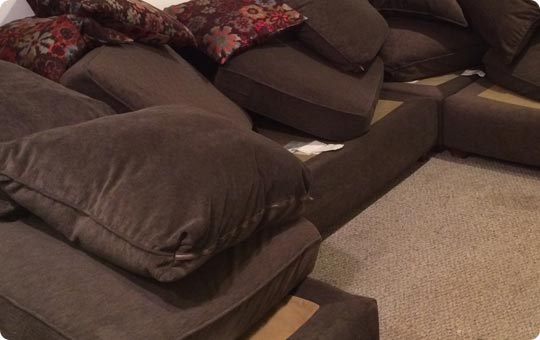When a spill happens on your sofa or armchair, the instinct is to grab a cloth, add some cleaner, and start scrubbing. The correct first step is much simpler: stop, find the care tag, and read the code.
W, S, SW (or WS), and X - are not just technical details. They are the manufacturer's guide to safe upholstery cleaning. Ignoring them is one of the fastest ways to cause permanent damage: water rings, rough texture, color bleeding, or even a ruined piece of furniture.
Read on to find out what each code means, what you can safely do at home, and when it is wiser to call professional upholstery cleaning services.
Upholstery today is more complex than it appears. Fabrics may include:
Each type responds differently to moisture, temperature, and cleaning agents. A universal cleaner that works on one sofa may permanently stain another.
Reading the tag before you clean helps you:
In short: the code is there to protect both your upholstery and your budget.
Use this summary as your starting point before any spot or deep cleaning.
| Code | Meaning | Safe Basic Approach | Risk If You Guess Wrong |
|---|---|---|---|
| W | Water-based cleaning | Light water-based cleaning with care | Low to moderate |
| S | Solvent-only cleaning | Dry solvent products, no water | High |
| SW | Water or solvent allowed | Either method, always test in a hidden area | Moderate |
| X | Vacuum only | Dry vacuuming, no liquids or chemicals | Very high (do not experiment) |
Now let's look at each code in a practical, professional context.
A W code indicates that the fabric can be cleaned with water-based solutions. This is generally the most "DIY-friendly" cleaning category.
What this means in practice:
However, W does not mean "soak freely". Over-wetting can push soil and moisture into the padding, leading to odors, yellowing, and uneven drying. Aggressive scrubbing can also distort fibers.
For regular maintenance, careful home cleaning is often enough. For deep soil, heavy use, or old stains, professional upholstery cleaning ensures proper product selection, controlled moisture, and thorough extraction.
S-coded fabrics are sensitive to water. Even small amounts of moisture can leave rings, cause shrinkage, or change the fabric's feel.
Key points for S code upholstery:
Because S fabrics are less forgiving, they are easy to damage with the wrong approach. Large, oily, or colored stains, as well as high-visibility areas (arms, seats, cushions), are best treated by experienced upholstery cleaners who understand solvent-safe techniques.
If you are unsure, treating S code upholstery as a "professional only" material is often the safest decision.
SW (or WS) means that both water-based and solvent-based products may be used, but only with testing and moderation.
Practical guidance:
Professionals often achieve the best results on SW fabrics by combining methods: targeted pre-treatment, controlled moisture, and powerful extraction. This reduces the risk of residue, over-wetting, and uneven appearance.
X is the strictest code: no water, no cleaning solutions, no solvent-based sprays.
These fabrics are typically decorative, delicate, or not designed for wet or chemical cleaning. Any attempt to treat stains with regular products can lead to irreversible damage.
For Code X:
Code X pieces are often high-value or design-focused. Professional assessment is strongly recommended if anything more than basic dust removal is needed.
Many homeowners discover that the label has been cut off, faded, or is simply not there. In that situation:
Guessing rarely saves money in the long run.
Regardless of code, consistent low-impact care significantly extends the life of your furniture:
These routines support both appearance and hygiene, making any professional cleaning more efficient and less frequent.
Certain situations call for expert attention, regardless of the code:
Professional upholstery cleaning services bring controlled techniques, fiber-specific solutions, proper rinse and extraction, and faster drying. The goal is not only stain removal, but safe restoration of the fabric's original look and feel.
A reputable upholstery cleaning company will:
If you remember only one guideline, let it be this: always read the tag before you clean.
Those small letters - W, S, SW, X - are your first and most important instructions. They help you decide what is safe to do yourself and when it is time to trust trained upholstery cleaners like Tulip Carpet Cleaning of East Brunswick to protect your furniture investment and keep your home comfortable, healthy, and looking its best.

